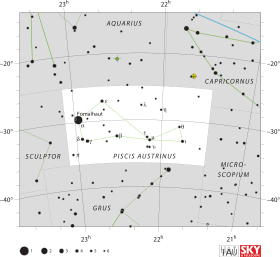Lambda Piscis Austrini
Lambda Piscis Austrini, Latinized from λ Piscis Austrini, is a solitary[10] star in the southern constellation of Piscis Austrinus. It has a blue-white hue and is visible to the naked eye with an apparent visual magnitude of +5.42.[2] Based upon an annual parallax shift of 6.51 mas as measured from Earth,[1] it is located around 500 light years from the Sun. At that distance, the visual magnitude of the star is diminished by an extinction factor of 0.16 due to interstellar dust.[5]
 | |
| Observation data Epoch J2000.0 Equinox J2000.0 (ICRS) | |
|---|---|
| Constellation | Piscis Austrinus |
| Right ascension | 22h 14m 18.75029s[1] |
| Declination | −27° 46′ 00.8756″[1] |
| Apparent magnitude (V) | +5.42[2] |
| Characteristics | |
| Spectral type | B7 V[3] |
| B−V color index | −0.12[2] |
| Astrometry | |
| Radial velocity (Rv) | −6.20[4] km/s |
| Proper motion (μ) | RA: +23.889[1] mas/yr Dec.: +2.562[1] mas/yr |
| Parallax (π) | 6.5148 ± 0.2222[1] mas |
| Distance | 500 ± 20 ly (153 ± 5 pc) |
| Absolute magnitude (MV) | −0.13[5] |
| Details | |
| Mass | 3.58±0.08[6] M☉ |
| Radius | 4.2[7] R☉ |
| Luminosity | 249[6] L☉ |
| Temperature | 12,023[6] K |
| Rotational velocity (v sin i) | 50[8] km/s |
| Age | 215[5] Myr |
| Other designations | |
| Database references | |
| SIMBAD | data |
This is a B-type main sequence star with a stellar classification of B7 V.[3] It has an estimated 3.58[6] times the mass of the Sun and about 4.2[7] times the Sun's radius. The star is spinning with a projected rotational velocity of 50 km/s[8] and is 76% of the way through its main sequence lifetime. It is radiating 249 times the solar luminosity from its photosphere at an effective temperature of 12,023 K.[6]
Lambda Piscis Austrini is moving through the Galaxy at a speed of 18.1 km/s relative to the Sun. Its projected Galactic orbit carries it between 23,800 and 29,300 light years from the center of the Galaxy.[11]
Naming
In Chinese, 羽林軍 (Yǔ Lín Jūn), meaning Palace Guard, refers to an asterism consisting of λ Piscis Austrini, 29 Aquarii, 35 Aquarii, 41 Aquarii, 47 Aquarii, 49 Aquarii, HD 212448, ε Piscis Austrini, 21 Piscis Austrini, 20 Piscis Austrini, υ Aquarii, 68 Aquarii, 66 Aquarii, 61 Aquarii, 53 Aquarii, 50 Aquarii, 56 Aquarii, 45 Aquarii, 58 Aquarii, 64 Aquarii, 65 Aquarii, 70 Aquarii, 74 Aquarii, τ2 Aquarii, τ1 Aquarii, δ Aquarii, 77 Aquarii, 88 Aquarii, 89 Aquarii, 86 Aquarii, 101 Aquarii, 100 Aquarii, 99 Aquarii, 98 Aquarii, 97 Aquarii, 94 Aquarii, ψ3Aquarii, ψ2Aquarii, ψ1Aquarii, 87 Aquarii, 85 Aquarii, 83 Aquarii, χ Aquarii, ω1 Aquarii and ω2 Aquarii. Consequently, the Chinese name for λ Piscis Austrini itself is 羽林軍六 (Yǔ Lín Jūn liù, English: the Sixth Star of Palace Guard.)[12]
References
- Brown, A. G. A.; et al. (Gaia collaboration) (August 2018). "Gaia Data Release 2: Summary of the contents and survey properties". Astronomy & Astrophysics. 616. A1. arXiv:1804.09365. Bibcode:2018A&A...616A...1G. doi:10.1051/0004-6361/201833051. Gaia DR2 record for this source at VizieR.
- Corben, P. M.; Stoy, R. H. (1968), "Photoelectric Magnitudes and Colours for Bright Southern Stars", Monthly Notes of the Astronomical Society of Southern Africa, 27: 11, Bibcode:1968MNSSA..27...11C.
- Houk, Nancy (1979), Michigan catalogue of two-dimensional spectral types for the HD stars, 3, Ann Arbor, Michigan: Department of Astronomy, University of Michigan, Bibcode:1982mcts.book.....H.
- Gontcharov, G. A. (November 2006), "Pulkovo Compilation of Radial Velocities for 35495 Hipparcos stars in a common system", Astronomy Letters, 32 (11): 759–771, arXiv:1606.08053, Bibcode:2006AstL...32..759G, doi:10.1134/S1063773706110065.
- Gontcharov, G. A. (November 2012), "Spatial distribution and kinematics of OB stars", Astronomy Letters, 38 (11): 694–706, arXiv:1606.09028, Bibcode:2012AstL...38..694G, doi:10.1134/S1063773712110035.
- Zorec, J.; Royer, F. (January 2012), "Rotational velocities of A-type stars. IV. Evolution of rotational velocities", Astronomy & Astrophysics, 537: A120, arXiv:1201.2052, Bibcode:2012A&A...537A.120Z, doi:10.1051/0004-6361/201117691.
- Pasinetti Fracassini, L. E.; et al. (February 2001), "Catalogue of Apparent Diameters and Absolute Radii of Stars (CADARS)", Astronomy and Astrophysics (3rd ed.), 367: 521–524, arXiv:astro-ph/0012289, Bibcode:2001A&A...367..521P, doi:10.1051/0004-6361:20000451.
- Abt, Helmut A.; et al. (July 2002), "Rotational Velocities of B Stars", The Astrophysical Journal, 573 (1): 359–365, Bibcode:2002ApJ...573..359A, doi:10.1086/340590.
- "lam PsA -- Star", SIMBAD Astronomical Database, Centre de Données astronomiques de Strasbourg, retrieved 2017-05-18.
- Eggleton, P. P.; Tokovinin, A. A. (September 2008), "A catalogue of multiplicity among bright stellar systems", Monthly Notices of the Royal Astronomical Society, 389 (2): 869–879, arXiv:0806.2878, Bibcode:2008MNRAS.389..869E, doi:10.1111/j.1365-2966.2008.13596.x.
- Anderson, E.; Francis, Ch. (2012), "XHIP: An extended hipparcos compilation", Astronomy Letters, 38 (5): 331, arXiv:1108.4971, Bibcode:2012AstL...38..331A, doi:10.1134/S1063773712050015.
- (in Chinese) AEEA (Activities of Exhibition and Education in Astronomy) 天文教育資訊網 2006 年 7 月 7 日